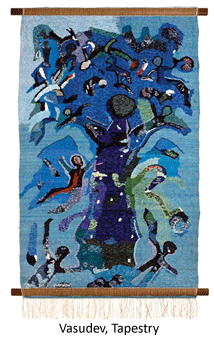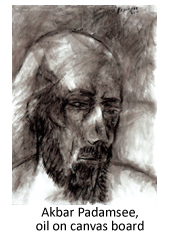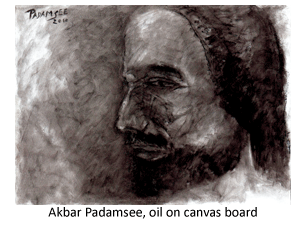- Prelude
- Editorial
- Manjit Bawa
- Husain's Calcutta
- Vivan's Visionary Reconstruction of History at Victoria Memorial, 1998
- The Remaking of Indian Painting
- Picasso Re-visited
- Benodebehari Mukherjee: A Recluse and the Centenary Show
- In Past and Present Continuum Speaking to Thota Vaikuntam
- The Importance of Being Husain
- Image-making to Image-circulation: Implicated Image(ry)
- 153 Years Old yet Young at Heart: Mumbai's Sir JJ School of Art
- Two Decades: A Critical Insight by an Art Critic and an Artist
- Biedermeier Style: Biedermeier Furniture
- Vacheron Constantin
- The Irony of Andy Warhol
- Then and Now: An Indian Perspective to the Art Market 1990-2010
- Pablo, Andy, Here I Come
- What Happened and What's Forthcoming
- Bid's Got Hammered?
- Anish Kapoor at National Gallery of Modern Art in Delhi and Mehboob Studio in Mumbai
- Tribute to Hemanta Misra: the “Calcutta Group” Painter
- Art Events Kolkata
- Mumbai Art Sighting
- Art Bengaluru
- Exploring the Riverine Culture of Bengal
- Alternative art practices define Bangalore
- India Art Summit Turns Three
- An Aesthetic Fair
- SSVAD: A New Arts Centre in Santineketan
- Visible Invisible by Siraj Saxena
- A Fleeting World : Paintings by Sunil De
- Previews
- In the News
ART news & views
Mumbai Art Sighting
Volume: 3 Issue No: 12 Month: 1 Year: 2011
The Month that was
A reflective moment
by Jasmine Shah Varma
Anish Kapoor's first ever show has been receiving hundreds of visitors at the Mehboob Studio in Mumbai. This account of the show will go easy on adjectives but endeavours to be an experiential one.  After all Kapoor's works are about the experience of the objects that he makes on a grand scale. The exhibition is on view till January 16, 2011.
After all Kapoor's works are about the experience of the objects that he makes on a grand scale. The exhibition is on view till January 16, 2011.
Mumbai-born, UK based Kapoor's wish to exhibit in India has been for very long. As a daily newspaper reporter back in 2000 one had hounded and chased the British Council in Mumbai to get a “breaking story” on the dates and venue for this show. After months of chase there were no answers and the story petered out. During his interaction with the Mumbai press in 2000 Kapoor had mentioned how they were scouting for an appropriate location. Seeing the scale of the works and the space required to view and experience them one can begin to understand why it took so long to actualize the plan. The wait was worth it.
At Stage 3 of the Mehboob Studio, a film studio in Mumbai's tony suburb Bandra, most works on display are the more recent ones made between 2006 and 2010 in the polished, reflective stainless steel genre. There is the performative Shooting into the Corner with the cannon-like device and red wax projectiles, and another wax-based work titled Stack. Those who are familiar with Kapoor's works or have seen them in images in art magazines and on the web have seen them reflect plain gallery walls and ceilings, or buildings or trees or the sky. At the Mehboob Studio one sees the reflections of the lights above, the walls, the viewers and other works which create an engaging interaction. These finely engineered and aesthetically shaped solid objects have fluid, constantly changing images on them. Every work distorts the images in different ways: images are inverted, they are elongated, they zoom in and zoom out, they blur and sometimes are clear, they are whole and they are fragmented. Every time you change your point of gaze - your perspective - even by a step the image changes. Other than the theatrical experience these works are about profound questions and thoughts about polarities, contradictions, about life, about the humanity, about perception and illusion. Kapoor's works transcend from being a visual experience to an interactive and a metaphysical one.
The reflections of the unkempt grey-black brick studio walls and uneven floors come across as the unexpected experiences if one is already familiar with his works. One reason that Kapoor's Chicago public space work Cloud Gate has viewers gazing at it with fascination for long hours is because the reflected scenery keeps changing. The reflective works are characterised by an ephemeral quality and offer different perspectives every few steps. People, blue sky, changing light, an occasional flight of a bird and the trees in the Millennium Park keep the image fluid.  The experience is that much more invigorating, egging the viewer to spend more time to contemplate and have quiet moments in front of the aesthetic workmanship. At Mehboob Studio the bland brick walls and selectively painted white walls do not hold the same ephemeral quality. But provide a differently engaging experience.
The experience is that much more invigorating, egging the viewer to spend more time to contemplate and have quiet moments in front of the aesthetic workmanship. At Mehboob Studio the bland brick walls and selectively painted white walls do not hold the same ephemeral quality. But provide a differently engaging experience.
For Kapoor there were considerations other than the vast space while choosing this historically important film studio. In interviews with the Mumbai press Kapoor said he saw the film studio as a space "where things were made, then emanated from for public viewing. Here bringing in the public, is reversing that process" (quoted from www.cnngo.com video film.) Much care and planning went into choosing locations and the works to be included in India. And one can see the importance of the location and context in which a work of art is placed.
The spectacular Shooting into the Corner (2008-09) has a cannon that goes off periodically. A man in a uniform takes one block of red wax from a nearby stack and shoots it into the corner of the white washed studio walls. Each time the projectile is shot, the loud impactful explosive sound makes you shudder. The connotation and interpretations of this work are many other than the obvious references to violence. This work creates drama in an otherwise quiet space. There's an interesting balance in the exhibition. The reflective steel works are created on a large scale after complex engineering but have an unassuming quality, they are quiet receptors. On the other hand the cannon work, a mathematically calculated and engineered work, is outright dramatic. In both genres Kapoor gives the viewer a vast spectrum of experiences.
This exhibition has reached out to hundreds of viewers and not just the niche audience that private art galleries usually receive. The scale, the execution and the arrangements have given a novel experience to the Mumbai art loving public. Indeed an unforgettable experience.
An almost retrospective
Bangalore based artist SG Vasudev's one-man show at Jehangir Art Gallery from December 6 to 18 provided a first time opportunity to view his works in four mediums. Drawings, paintings, copper relief and tapestries were exhibited while a 45-minute documentary on the 70-year-old artist was also available for viewing. Mumbai is the first venue before the show travels to Delhi and other cities in India in 2011.
The first section of the well-mounted exhibition included his drawings, an introduction to the basic form, lines and structure of his work. Next on display were oil on canvases where the lines and structures were fleshed out in expressive colours. From the video one gathered his work process. He takes a blank canvas, coats it with thick layers of white, till it's almost slushy. Then he etches the form on the paint with a sharp tool, followed by application of other colours with brushes and knifes. A fascinating process to watch as the spontaneous imagery emerges from scratch. Pun intended. The paintings seem to have an ambition for sculptural quality which is achieved in the copper bas-reliefs, too. Those are next in the sequence in the display. The tactile, textural qualities are heightened as Vasudev plays with the reliefs techniques. While one can see the continuation in the form and the central preoccupation, each medium speaks for the artist with its inherent strength. Most of the works from drawings to copper reliefs are between 2007 to 2010. In the second section of the Jehangir Art Gallery, Vasudev exhibited the tediously woven tapestries that spanned 18 years of his collaborative efforts. The images are from his original paintings and so one gets to see his trajectory as an artist over the last 18 years in these tapestries. This is why I call this show an almost-retrospective. The exhibition gives an insight into the artist's ways of handling various mediums and how he expresses the concepts of life, nature, humanity and creation.
Portraits of another kind
 Akbar Padamsee's exhibition at Pundole Art Gallery was also an occasion for the first screening of a documentary film on him by his son-in-law Laurent Bregeat produced by the Lalit Kala Akademi. A well-made film that captures the life of the artist from his early years to the present. The articulate artist fills us with anecdotes that shaped his life and career. The film also captures him in the process of painting and creating the famous metascape and the head paintings which are the hallmark of his work.
Akbar Padamsee's exhibition at Pundole Art Gallery was also an occasion for the first screening of a documentary film on him by his son-in-law Laurent Bregeat produced by the Lalit Kala Akademi. A well-made film that captures the life of the artist from his early years to the present. The articulate artist fills us with anecdotes that shaped his life and career. The film also captures him in the process of painting and creating the famous metascape and the head paintings which are the hallmark of his work.
 At the Pundole Art Gallery a series of monochromatic heads in oil on canvas boards and lithographs were displayed. Rather than seeing them as portraits of people these are portraits of emotions, of a contemplative moment, of awakening or slumberous instance that Madame captures. In the catalogue note on this collection he says: “It seems to me that it is not possible to ever exhaust all possibilities of imagining the human head each similar and yet so dissimilar to the other.” That may put to rest the thought that Padamsee has been working on one theme for too long.
At the Pundole Art Gallery a series of monochromatic heads in oil on canvas boards and lithographs were displayed. Rather than seeing them as portraits of people these are portraits of emotions, of a contemplative moment, of awakening or slumberous instance that Madame captures. In the catalogue note on this collection he says: “It seems to me that it is not possible to ever exhaust all possibilities of imagining the human head each similar and yet so dissimilar to the other.” That may put to rest the thought that Padamsee has been working on one theme for too long.
Among other shows
Plenty happened in Mumbai in December including an exhibition of recent works by Delhi-based Jatin Das at the Museum Gallery presented by Gallery Art & Soul. Young artist Aditi Singh's solo show of works on paper opened at Gallery Chemould. Let It Be a Heaven of Blackred Roses closes on January 6. Gallery Maskara is showing two 30-plus feet inflatable white horses by Toronto-based Max Streicher. Ashwamedh is on view till January 30. Through December 16 to and February 15 Volte is showcasing Sweet Unease, a solo show of one of India's under-celebrated artists Ranbir Kaleka.